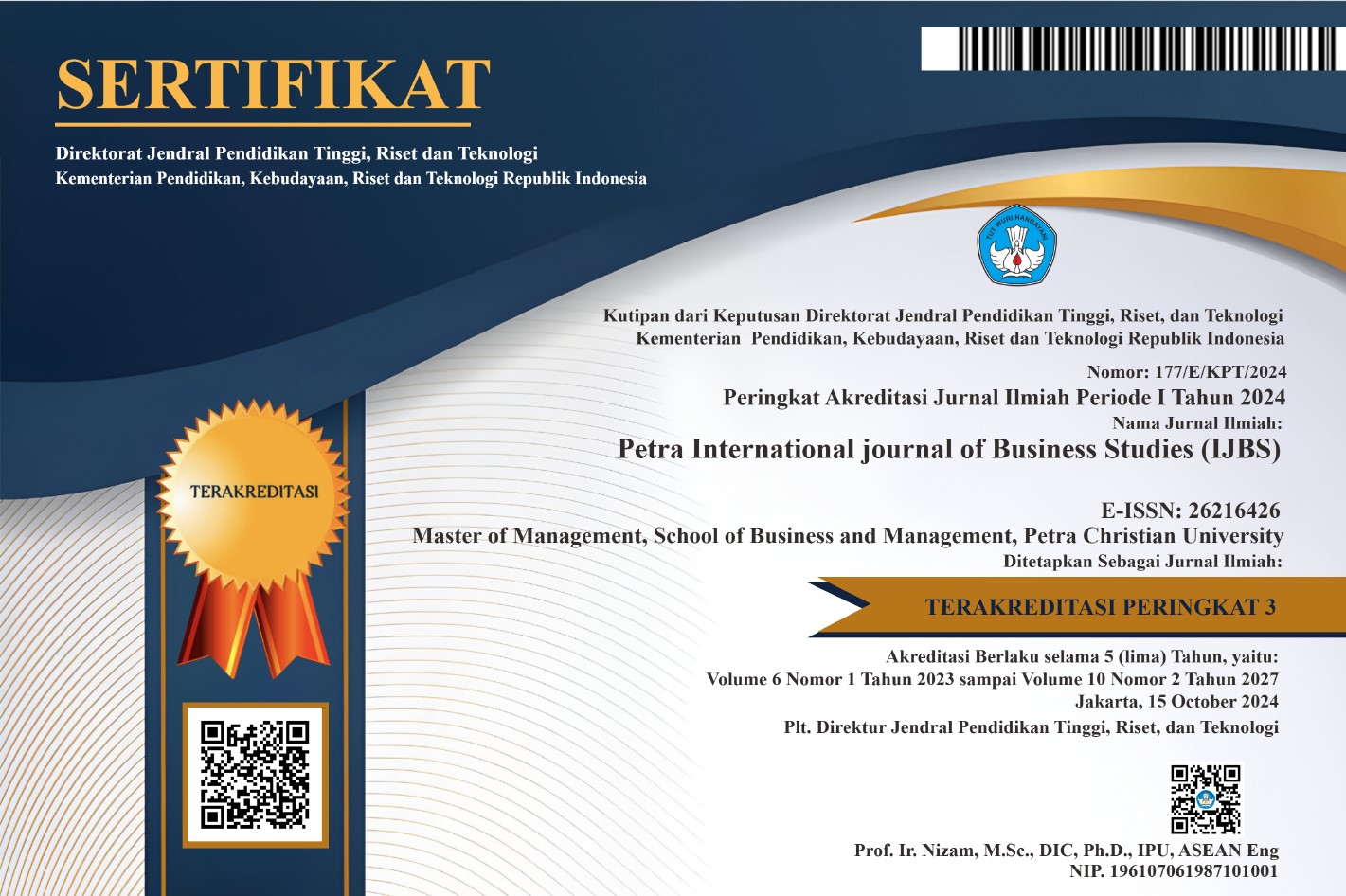Supply Chain Performance Measurement at XYZ Company Distribution Center Using SCOR 12
DOI:
https://doi.org/10.9744/petraijbs.7.1.66-79Keywords:
Supply Chain, Performance Measurement, Retail, Analytical Hierarchy Process, Snorm De Boer, Supply Chain Operation Reference (SCOR)Abstract
Recognizing the limitations of their current, subjective evaluation system focused solely on delivery, XYZ Company seeks to implement a more standardized and comprehensive approach to supply chain performance measurement. This research aims to evaluate the performance of XYZ Company's Distribution Center (DC) supply chain using the well-established Supply Chain Operations Reference (SCOR) model. SCOR provides a validated set of performance indicators, which will be further weighted using the Analytical Hierarchy Process (AHP) to reflect their relative importance to XYZ Company's specific goals. The Snorm De Boer method will then be employed to normalize the final score for each indicator. A traffic light system will visually represent performance gaps, highlighting areas requiring immediate improvement. This research will analyze data from 27 key metrics across 2022 and 2023, providing a holistic picture of DC performance. While preliminary results indicate an overall "average" to "good" performance (69.54 and 70.08, respectively), further analysis will identify specific areas for improvement based on SCOR Best Practices. This research will ultimately propose practical solutions to enhance XYZ Company's overall supply chain efficiency and effectiveness.
Downloads
References
Aini, Q., Pratama, A. M., & Yasmin, F. D. (2018). Analisis kinerja rantai pasok dengan Supply Chain Operation Research (SCOR) dan AHP. Sebatik, UIN Syarif Hidayatullah, 1(1). Doi: 10.46984/sebatik. v23i1.439.
APICS. (2017). SCOR Supply Chain Operation Reference Version 12. Chicago: APICS
Beverley Sithole, Sergio Guedes Silva, Mirjana Kavelj, (2016). Supply Chain Optimization: Enhancing end-to-end visibility. Procedia Engineering, 159, 12-18. https://doi.org/10.1016/j.proeng.2016.08.058
Chopra, & Meindl. (2016). Supply chain management: strategy, planning, and operation (6th ed.). Pearson Education, Inc.
Fauziah, S. A., & Muftiadi, A. (2024). Performance measurement analysis of supply chain using the Supply Chain Operations Reference (SCOR) method version 12.0 (studies on 25 kg medium rice products at PT.XYZ). Jurnal Ekonomi Pertanian dan Agribisnis, 8(1), 377. https://doi.org/10.21776/ub.jepa.2024.008.01.31
Helm, R., Mauroner, O., & Pöhlmann, K. (2016). Towards a better understanding of performance measurements: the case of research-based spin-offs. Review of Managerial Science, 12(1), 135–166. https://doi.org/10.1007/s11846-016-0217-9
Jiputra, J. A., Tarigan, Z. J. H., & Siagian, H. (2020). The effect of information technology on retailer satisfaction through supply chain management practices and retailer-distributor relationship in modern retailer Surabaya. Petra International Journal of Business Studies, 3(2), 126–134. https://doi.org/10.9744/ijbs.3.2.126-134
MacCarthy, B.L., Blome, C., Olhager, J., Srai, J.S., Zhao, X. (2016). Supply chain evolution—Theory, concepts and science. International Journal of Operations & Production Management, 36, 1696–1718.
Prasetyo, D., Emaputra, A., & Parwati, C. (2021). Pengukuran kinerja supply chain management menggunakan pendekatan model Supply Chain Operations Reference (SCOR) pada IKM Kerupuk Subur. Jurnal Penelitian dan Aplikasi Sistem & Teknik Industri (PASTI)
Pujawan, I., N., & Mahendrawathi. (2010). Supply chain management Edisi Kedua. Guna Widya: Surabaya
Raharja, Muyi, & Adiprihadi. (2022). Contribution of the retail sector towards city economy: Study in Bandung City, Indonesia. Review of Integrative Business and Economics Research, 10(2), 19–32.
Rainer. (2011). Introduction to information systems: supporting and transforming business. (Third Edition). New Jersey: John Wiley & Son, Inc
Reddy. K, J. M., Rao. A, N., & L, K. (2019). A review on supply chain performance measurement systems. Procedia Manufacturing, 30, 40–47. https://doi.org/10.1016/j.promfg.2019.02.007
Setyawan Firmansyah, H., & Siagian, H. (2022). Impact of information sharing on supply chain performance through supplier quality management, supply chain agility, and supply chain innovation. Petra International Journal of Business Studies, 5(2), 119–131. https://doi.org/10.9744/ijbs.5.2.119-131
Sucahyowati, H. (2011). Manajemen rantai pasok (supply chain management). Majalah Ilmiah Gema Maritim, 13(1), 20–28. https://doi.org/10.37612/gemamaritim.v13i1.19
Sumiati. (2006). Pengukuran performansi supply chain perusahaan dengan pendekatan Supply Chain Operation Reference (SCOR) di PT. Madura Guano Industri (KAMALMADURA). Surabaya: UPN Veteran Jawa Timur.
Tannady. (2015). Pengendalian kualitas. Indonesia: Graha Ilmu
Teja, D., & Vanany, I. (2022, March). Design for supply chain performance measurement in fast-food restaurant Franchise. In 12th Annual International Conference on Industrial Engineering and Operations Management. https://doi.org/10.46254/AN12.20220474
Wulan, A. R. (2007). Pengertian dan esensi konsep evaluasi, asesmen, tes dan pengukuran. FPMIPA Universitas Pendidikan Indonesia, Bandung. Indonesia.
Additional Files
Published
Issue
Section
License
Copyright (c) 2024 David Prasetya, Anggoro Prasetyo Utomo, Marla Setiawati

This work is licensed under a Creative Commons Attribution 4.0 International License.
Petra IJBS (e-ISSN: 2621-6426) is published by Master of Management program, School of Business and Management, Petra Christian University, Indonesia (MM SBM PCU).












